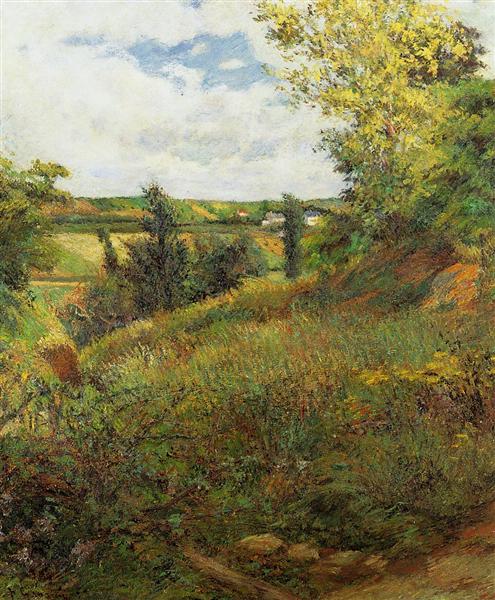Descrizione
Paul Gauguin's Gratte Roosters Path, painted in 1882, encapsulates a crucial transition in the development of the painter's artistic language and his exploration of form and colour. Part of the period when Gauguin sought to move away from the conventions of academic art, this painting is distinguished by its focus on depicting everyday life through a modernist lens that anticipates his later work in Polynesia.
The composition of the work is characterised by a balanced arrangement of elements and a subtle use of depth. At first glance, the scene appears simple: a country road adorned by a series of roosters displayed in different attitudes. However, the choice of these elements reveals a deeper intention. The roosters, in their symbolism of vitality and territoriality, seem to be in a tacit dialogue with their surroundings, and act as guardians of the narrow path that runs through a landscape that exudes calm and naturalness. This focus on the representation of fauna reflects Gauguin’s interest in the nuances of life in its purest context, a reflection of his fascination with simplicity and authenticity.
Color is a central aspect in “The Roosters’ Path.” Gauguin uses a vibrant palette that evokes the intensity of natural light in the countryside. Deep blues and harmonious greens combine with the vibrant red of the roosters, creating a contrast that draws the viewer’s eye to the protagonists of the work. This use of color not only serves to define the constitutive elements of the painting, but also sets an emotional tone that invites contemplation and connection with the serenity of the scene.
In addition to its mastery of color and compositional construction, "Rooster's Path" reveals Gauguin's ability to suggest movement and life in what might at first glance be interpreted as a static scene. The roosters, with their bright plumage, seem to come alive in the stillness of the landscape, and their arrangement on the path conveys a sense of direction and purpose. This characteristic is emblematic of the modernist approach that Gauguin took, seeking not only to depict reality, but also to convey an emotional experience through his art.
It is worth mentioning that Gauguin's interest in rural life and natural elements could be influenced by his desire to escape from urban life and his search for new artistic and spiritual experiences. His style, which would develop towards symbolism and the use of non-naturalistic colours in his later paintings, already begins to be glimpsed in this work. "Rooster's Path" can be understood as a step in his evolution, where both respect for pictorial tradition and the desire to innovate and explore new ways of representing reality are manifested.
While the painting may not feature human characters, the mood it evokes, accompanied by the presence of birds, suggests a symbolic connection with the human being, which Gauguin often sought to express in his work. This focus on nature and country life may be reminiscent of contemporary works by other artists who also explored rural life, though Gauguin's tone and execution are unmistakable in their uniqueness.
In short, "Roosters' Path" is a work that captures the essence of a crucial moment in Paul Gauguin's career, where one can observe the first glimpses of his artistic mastery and his relentless search for a representation that transcends the merely visual. Through his composition, use of color, and subtle connection with the natural world, Gauguin provides a vision that invites reflection and appreciation of life in its most genuine form.
KUADROS ©, a famous painting on your wall.
Hand-made oil painting reproductions, with the quality of professional artists and the distinctive seal of KUADROS ©.
Painting reproduction service with satisfaction guarantee. If you are not completely satisfied with the replica of your painting, we will refund 100% of your money.

